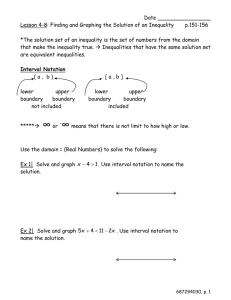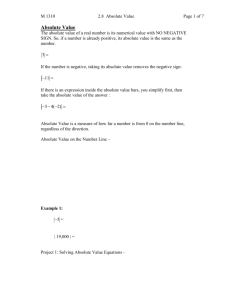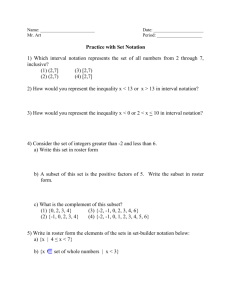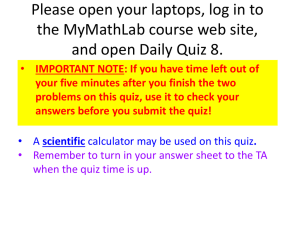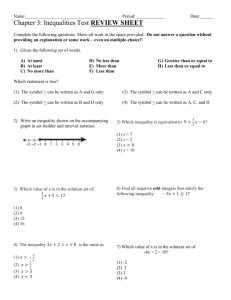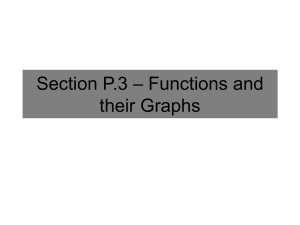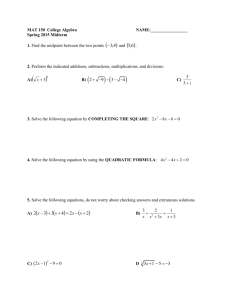Section 1.1 Real Numbers and Number Operations
advertisement
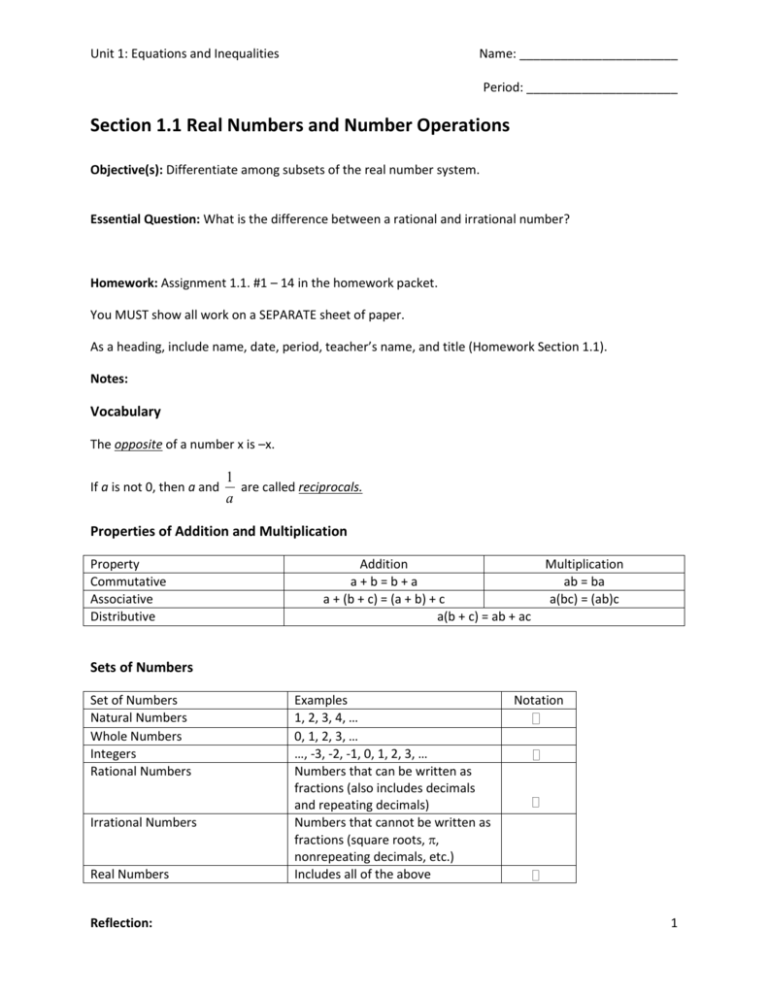
Unit 1: Equations and Inequalities
Name: _______________________
Period: ______________________
Section 1.1 Real Numbers and Number Operations
Objective(s): Differentiate among subsets of the real number system.
Essential Question: What is the difference between a rational and irrational number?
Homework: Assignment 1.1. #1 – 14 in the homework packet.
You MUST show all work on a SEPARATE sheet of paper.
As a heading, include name, date, period, teacher’s name, and title (Homework Section 1.1).
Notes:
Vocabulary
The opposite of a number x is –x.
If a is not 0, then a and
1
are called reciprocals.
a
Properties of Addition and Multiplication
Property
Commutative
Associative
Distributive
Addition
a+b=b+a
a + (b + c) = (a + b) + c
a(b + c) = ab + ac
Multiplication
ab = ba
a(bc) = (ab)c
Sets of Numbers
Set of Numbers
Natural Numbers
Whole Numbers
Integers
Rational Numbers
Irrational Numbers
Real Numbers
Reflection:
Examples
1, 2, 3, 4, …
0, 1, 2, 3, …
…, -3, -2, -1, 0, 1, 2, 3, …
Numbers that can be written as
fractions (also includes decimals
and repeating decimals)
Numbers that cannot be written as
fractions (square roots, ,
nonrepeating decimals, etc.)
Includes all of the above
Notation
1
Real Numbers
Irrational Numbers
Rational Numbers
Integers
Whole
Natural
Tell which set or sets the number belongs to: natural numbers, whole numbers, integers, rational
numbers, irrational numbers, and real numbers.
Circle ALL correct choices.
Example 1:
3
natural, whole, integer, rational, irrational, real
Example 2:
4
natural, whole, integer, rational, irrational, real
Example 3:
-7
natural, whole, integer, rational, irrational, real
Example 4:
0.123123123…
natural, whole, integer, rational, irrational, real
Example 5:
29
natural, whole, integer, rational, irrational, real
Example 6:
0
natural, whole, integer, rational, irrational, real
Write a sentence using mathematical symbols.
Example 7:
The difference of 3 times x and 4 is greater than 12.
_________________________
Example 8:
Five times x is 32 more than twice x.
_________________________
Example 9:
The quotient of 18 and x equals 6.
_________________________
Example 10:
The sum of twice x and 7 is 19.
_________________________
Example 11:
Twice the sum of x and 7 is 19.
_________________________
Example 12:
Nine subtracted from 4 times x is equal to 100.
_________________________
Reflection:
2
Section 1.2 Algebraic Expressions and Models
Objective(s): Simplify numerical and algebraic expressions applying the appropriate field properties.
Essential Question: Describe what it means for terms to be like terms and give an example.
Homework: Assignment 1.2. #15 – 37 in the homework packet.
You MUST show all work on a SEPARATE sheet of paper.
As a heading, include name, date, period, teacher’s name, and title (Homework Section 1.2).
Notes:
Vocabulary
A letter that represents a number is called a variable.
An exponent is a shorthand notation for repeated multiplication of the same factor.
An algebraic expression is formed by numbers and variables connected by the operations of addition,
subtraction, multiplication, division, raising to powers, and/or taking roots.
Order of Operations
1. Grouping symbols (including parentheses, brackets [ ], braces { }, absolute value | |, and the
fraction bar)
2. Exponents (including square roots, cube roots, etc.)
3. Multiplication and Division (left to right)
4. Addition and Subtraction (left to right)
Note: When simplifying a numeric expression, parentheses, brackets, and braces all mean the same
thing. Work from the inside out. This usually means do the parentheses, and then the brackets, and then
the braces.
Mnemonic device for the Order of Operations: PEMDAS or “Please Excuse My Dear Aunt Sally”
Note: Be careful when using this mnemonic device. Remember that multiplication/division and
addition/subtraction are performed left to right!
Evaluate the expression 2 x 2 6 x 3 y 2 5 when x 3 and y 5 .
Substitute values for x and y:
Reflection:
2 3 6 3 3 5 2 5
2
3
2 3 6 3 15 2 5
2
Grouping symbols:
2 3 6 12 2 5
2
Exponents:
2 9 6 12 2 5
Mult/Div Left to Right:
18 72 2 5
18 36 5
Add/Sub Left to Right:
18 5
13
Simplify the expression.
Example 1:
18 2 6
What do you do first? _____________________
What do you do second? __________________
Answer: ________________________________
Example 2:
42 2 5
What do you do first? _____________________
What do you do second? __________________
What do you do third? ____________________
Answer: ________________________________
Example 3:
1 1 1
6 3 4
Answer: ________________________________
Example 4:
3 7 2 8 3
What do you do first? _____________________
What do you do second? __________________
What do you do third? ____________________
Answer: ________________________________
Reflection:
4
Evaluate the expression for the given replacement values.
Example 5:
14 x 9 y
x5
for x = 7 and y = 5
Answer: ________________________________
Example 6:
(x + 3y)2
for x = 2 and y = 4
Answer: ________________________________
Example 7:
-4(3x + 8y)
for x = 2 and y = 1/8
Answer: ________________________________
Simplifying Algebraic Expressions
To simplify an algebraic expression, eliminate parentheses using the distributive property and combine
like terms. Terms are separated by (+) or (–) signs.
What is the simplified form of the expression?
Example 8:
5 + (2k + 6)
Example 9:
-5m + 4 – 6 + 4 + m – 2
Example 10:
6(5m – 3) – 2(3m + 6)
Reflection:
5
Sample CCSD Common Exam Practice Question(s):
1. To which sets of numbers does
3
belong?
5
I. integers
II. natural numbers
III. rational numbers
IV. real numbers
V. whole numbers
A. I, III, and IV only
B. II and IV only
C. III and IV only
D. III, IV, and V only
2. Evaluate (3c d ) when c 1 and d 5 .
A. 8
B. 2
C. 3
D. 8
3. Which is a simplified form of the expression 3( x 2) 5(2 x 4) ?
A. 16x
B. 19x
C. 7 x 2
D. 7 x 26
Reflection:
6
Section 1.3 Solving Linear Equations
Objective(s): Solve linear equations in one variable.
Essential Question: What role does the order of operations play when solving an equation?
Homework: Assignment 1.3. #38 – 52 in the homework packet.
You MUST show all work on a SEPARATE sheet of paper.
As a heading, include name, date, period, teacher’s name, and title (Homework Section 1.3).
Notes:
To solve an equation, we use the properties of equality to isolate the variable on one side of the
equation.
When isolating the variable, we will “undo” addition/subtraction first, then multiplication/division. This
is the order of operations in reverse!
Ex: Solve the equation 8x 6 5 .
Step One: Subtract 6 from both sides.
8x 1
Step Two: Divide both sides by 8 .
x
1
8
For more complicated equations, you may have to simplify both sides of the equation first using the
distributive property and combining like terms.
Ex: Solve the equation 6 x 4 2 x 24
Step One: Use the distributive property.
6x 24 2 x 24
Step Two: Combine like terms.
4 x 24 24
Step Three: Add 24 to both sides.
4 x 48
Step Four: Divide both sides by 4.
x 12
Reflection:
7
If there are variables on both sides, you will need to simplify both sides of the equation and then bring
all variables to the same side using inverse operations.
Ex: Solve the equation 3x 2 4 x 6
Step One: Use the distributive property.
3x 2 4 x 24
Step Two: Subtract 3x from both sides.
2 x 24
Step Three: Subtract 24 from both sides.
26 x
Note: We can also write the answer in set notation. The solution set to the equation above is 26 .
When solving an equation with fractions, it saves time to “wipe-out” the fractions by multiplying both
sides by the LCM (least common multiple).
Ex: Solve the equation:
3
9 1
x 2x
5
10 3
The LCM of the fractions is 30.
“Multiply” every term (NUMERATOR ONLY) in the equation by 30 – but don’t actually multiply
because you cancel first.
30
3
9
1
x 30 30 30 2 x
5
10
3
30
3
9
1
x 30 30 30 2 x
5
10
3
6 3x 3 9 10 1 30 2 x
18 x 27 10 60 x
27 10 42 x
37 42 x
37
x
42
Solve the equation.
Example 1:
-5n = -15
Example 2:
10r + 12 = 62
Reflection:
8
Example 3:
6(3x – 1) = 24
What do you have to do first? ______________________
Example 4:
-2x – 7x + 6 = 2x
Example 5:
1
x 3 1
7
What do you have to multiply the numerators by? ______
Example 6:
5 1
7
x
3 2
6
What do you have to multiply the numerators by? ______
Example 7:
1
1
4
x2 x
3
6
3
Sample CCSD Common Exam Practice Question(s):
1. What is the value of x when
2
1 5
x ?
3
2 6
A. x
2
9
C. x
5
7
B. x
1
2
D. x
3
2
Reflection:
9
Section 1.4 Rewriting Equations and Formulas
Objective(s): Solve for a given variable in an equation with more than one variable.
Essential Question: Describe a real-life situation where you would need to be able to solve the area
formula of a circle for r.
Homework: Assignment 1.4. #53 – 61 in the homework packet.
You MUST show all work on a SEPARATE sheet of paper.
As a heading, include name, date, period, teacher’s name, and title (Homework Section 1.4).
Notes:
The equation 3x 2 y 5 is an example of an equation that is implicitly defined. Sometimes it is useful
to rewrite the equation so that it is explicitly defined, which means it is solved for one of the variables
(almost always solving for y).
Ex: Solve the equation 3x 2 y 5 for y .
Step One: Subtract 3x from both sides.
2 y 5 3x
Step Two: Divide both sides by 2.
y
5 3
x
2 2
Note: There are many ways to write the correct answer. This equation is equivalent to the
following:
3
5
y x
(most typical) and
2
2
y
5 3x
2
(hardly ever)
Sometimes it is useful to solve formulas for one of the variables.
Ex: Solve the formula for the area of a trapezoid for b1 .
A
1
h b1 b2
2
Step One: Multiply both sides by 2 (LCD).
2A h b1 b2
Step Two: Use the distributive property.
2A hb1 hb2
Reflection:
10
Step Three: Subtract hb2 from both sides.
2A hb2 hb1
Step Four: Divide both sides by h .
2 A hb2
b1 or
h
2A
b2 b1
h
Note: LOOK for opposites. These questions will always be multiple choice. If the original problem has
addition, then the answer MUST have subtraction. If the original problem has division, then the
answer MUST have multiplication, etc.
Solve the formula for the specified variable.
Example 1:
E = mc2
for c
Em
2
E
B. c
2m
A. c
C. c
E
m
D. c
Em
Example 2:
1
V r 2h
3
for r
3V
h
3V
B. r
h
A. r
V
3 h
V
D. r
3 h
C.
r
Sample CCSD Common Exam Practice Question(s):
1. Which represents y in terms of x for the equation 2 x 5 y 6 x 10 x 8 y ?
A. y
Reflection:
1
x2
2
B. y
3
x2
2
C. y
7
x2
2
D. y
9
x2
2
11
Section 1.5 Problem Solving Using Algebraic Models
Objective(s): Develop a mathematical model to solve real-world equations.
Essential Question: List and describe the steps of a problem solving plan.
Homework: Assignment 1.5. #62 – 65 in the homework packet.
You MUST show all work on a SEPARATE sheet of paper.
As a heading, include name, date, period, teacher’s name, and title (Homework Section 1.5).
Notes:
When you have a real world (word problem) that requires you to write an equation in slope-intercept
form, there are two things that you want to look for:
Example 1:
You are visiting a Baltimore MD, and a taxi company charges a flat fee of $3.00 for using
the taxi and an additional $0.75 per mile. Let C represent the total cost and x represent the number of
miles. Write a model for the total cost of the taxi ride.
What is the flat fee? __________________________
What is the rate? _________
Model ____________________________________
Reflection:
12
Example 2:
In 1960, the average life-span of an American woman was 73 years. Every year (since
1960), the life-span for American women has increased by 0.2 years. Let A represent the average lifespan and t represent the number of years since 1960. Write a model for the average life-span of an
American woman.
Example 3:
A plumber charges a fee of $50 to make a house call. He also charges $25 per hour for
labor. Let C represent the total cost and h represent the number of hours of the house call. Write a
model for the total cost of the plumbers house call.
Sample CCSD Common Exam Practice Question(s):
1. The cost for parts to repair a car was $1,015. The cost for labor was $70 per hour. Which of
the following is a linear model for the total cost of repairing the car where n represents the
number hours of labor?
A. C 70n 1015
B. C 1015n 70
C. C 70n 1015
D. C 1015n 70
Reflection:
13
Section 1.6 Solving Linear Inequalities
Objective(s): Solve linear inequalities in one variable.
Essential Question: When solving an inequality, when must you flip the sign, and why?
Homework: Assignment 1.6. #66 – 88 in the homework packet.
You MUST show all work on a SEPARATE sheet of paper.
As a heading, include name, date, period, teacher’s name, and title (Homework Section 1.6).
Notes:
Inequality Symbols:
Greater Than
Greater Than or Equal To
Less Than
Less Than or Equal To
Graphing an Inequality: Use parentheses for greater than (>) or less than (<). Use a bracket for
greater than or equal to ( ) or less than or equal to ( ).
Ex: Graph the inequality x 8
)
0 1 2 3 4 5 6 7 8 9
Graph the inequality on a number line.
Example 1:
x3
Example 2:
x<1
Example 3:
-8 < x -4
Example 4:
0<x<7
Interval notation is a notation for representing an interval as a pair of numbers. The numbers are the
endpoints of the interval. Parentheses and/or brackets are used to show whether the endpoints are
excluded or included. For example, [3, 8) is the interval of real numbers between 3 and 8, including 3
and excluding 8.
Write examples #1 – 4 in interval notation.
Example 5:
x3
Example 7:
-8 < x -4
Example 6:
x<1
Example 8:
0<x<7
Reflection:
14
Graph the set of numbers given in interval notation.
Example 9:
( -3, ∞)
Example 10:
( 9, 12]
Solving a Linear Inequality: solving an inequality is similar to solving an equation, with one exception.
*When multiplying or dividing by a negative number in an inequality, you must FLIP the inequality sign*
Ex: Solve the inequality x 4 .
To isolate the variable, we subtract 4 from both sides and add x to both sides to obtain 4 x .
Which, written with the variable on the left would read x 4 .
(ALWAYS write your answer with the variable on LEFT.)
An alternative way to solve this inequality would be to divide both sides by 1 .
x 4
1 1
Note: We needed to FLIP (reverse) the inequality symbol!
Solve the inequality. Graph the solution set. Then write the solution in interval notation.
Example 11:
9x – 11 > 8x – 14
Graph:
Interval Notation: _____________________
Example 12:
1
x3
6
Graph:
Interval Notation: _____________________
Example 13:
-5(4x + 13) < -25x – 35
Graph:
Interval Notation: _____________________
Reflection:
15
Compound Inequalities are two inequalities joined by “and” or “or”
Ex: x 5 or x 2
Ex: x 3 and x 4
Note: This can also be written as 3 x 4
Solving a compound inequality
Isolate the variable. In an “and” statement, isolate the variable between the two inequality signs. What
you do to the middle, you must do to all sides!
Ex: Solve and graph: 3 1 2 x 5
Step One: Add 1 to the middle and both sides
2 2 x 6
Step Two: Divide the middle and both sides by 2
1 x 3
Don’t forget to FLIP!
Step Three: Rewrite the inequality (smallest number on the left) 3 x 1
Step Four: Graph on a number line or write in interval notation
Ex: Solve and graph: 6x 5 7 or 8x 1 25
Step One: Solve both inequalities separately
6x 12
8x 24
x2
x3
Step Two: Write the solutions as a compound inequality
x 2 or x 3
Step Three: Graph on a number line or write in interval notation.
Solve the inequality. Graph the solution set and write it in interval notation.
Example 14:
5 3x 4 14
Graph:
Interval Notation: _____________________
Example 15:
9x – 6 < 3x or -2x -6
Graph:
Reflection:
16
Interval Notation: _____________________
Example 16:
-3x + 1 7 or -5x + 3 -17
Graph:
Interval Notation: _____________________
Sample CCSD Common Exam Practice Question(s):
1. Which expresses all of the solutions for the compound inequality below?
2 3 x 5 or 3( x 8) 3
A. 1 x 9
B. x = 1 or x = 9
C. x 1 or x 9
D. no solution
Reflection:
17
Section 1.7 Solving Absolute Value Equations
Objective(s): Solve absolute value equations in one variable.
Essential Question: Explain why there are two solutions to an absolute value equation.
Homework: Assignment 1.7. #89 – 96 in the homework packet.
You MUST show all work on a SEPARATE sheet of paper.
As a heading, include name, date, period, teacher’s name, and title (Homework Section 1.7).
Notes:
Vocabulary
The absolute value of a number is the distance between the number and 0 on the number line.
Ex: Solve the absolute value equation: x 3
Note: This means that the distance from the origin is 3.
Solution: There are two numbers that are 3 units away from the origin: x 3 and x 3
-3 -2 -1 0 1 2 3
4 5
Solving an absolute value equation
When solving an absolute value equation in the form ax b c , you must solve the equations
ax b c and ax b c .
Ex: Solve the absolute value equation: 5x 1 3 14
Step One: Isolate the absolute value ax b c .
5x 1 11
Step Two: Rewrite as two equations.
5x 1 11
5x 1 11
Step Three: Solve both equations.
5x 10
5x 12
Solutions:
x2
or
x
12
5
Note: You can check your solutions by substituting them back into the original equation.
Reflection:
18
What is the solution set of the absolute value equation?
Example 1:
|x – 3| = 5
Equation 1: ___________________
Equation 2: ___________________
Solution 1: ___________________
Solution 2: ___________________
Example 2:
|5x + 9| = 3
Solution 1: ___________________
Example 3:
|8x + 6| + 4 = 11
Solution 1: ___________________
Example 4:
Solution 2: ___________________
Solution 2: ___________________
|3x + 4| + 7 = 15
Solution 1: ___________________
Solution 2: ___________________
Sample CCSD Common Exam Practice Question(s):
1. What is the solution set of 4 x 8 20 ?
A. {7}
B. {7,3}
C. {3}
D. {3, 7}
Reflection:
19

